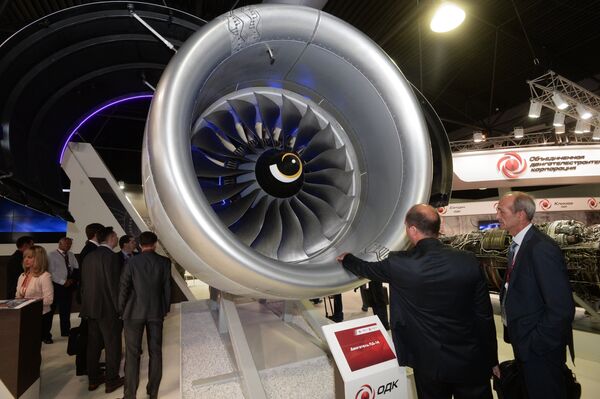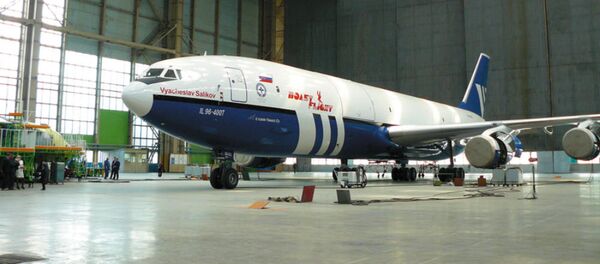On Tuesday, Russian business newspaper Kommersant reported, citing a source familiar with the situation, that the new version of the Ilyushin Il-96, presently under development, is designed to replace foreign-leased long-haul wide-body passenger aircraft whose service life is nearing its end. Next week, the responsible ministries are expected to draw up a timetable for the withdrawal of these foreign aircraft from Russia's airlines, and their substitution with the new Ilyushin.
The decision to revive production of the Il-96, an advanced, long-range version of the Soviet-era Ilyushin Il-86 wide-body airliner, was made in May 2016. At that time, Industry and Trade Minister Denis Manturov said that the government will be committing about 50 billion rubles to the program.
However, due to the economic crisis facing Russia and the rest of the former Soviet Union throughout the 1990s, only 30 units of the prospective aircraft were ever built. Today, Aeroflot is believed to have between 8-10 Il-96s in their inventory. However, according to aviation expert and former Vnukovo Airlines flight director Yuri Sytnik, these planes have all been decommissioned after putting on 55,000 flight hours.

However, in the mid-2010s, after the downturn in relations with Western countries in 2014 over the crisis in Ukraine, the Russian government started paying greater attention to the domestic commercial passenger aircraft industry, devoting energy and resources to encourage development, production and sales of modern aircraft at home, and promoting them abroad.
Speaking to RIA Novosti about the prospects of the new Il-96-400M, Sytnik noted that "if the Il-96 did get an upgrade, what we would get is a model quite comparable to some Boeing and Airbus planes."

Of course, he added, for a design from the late 1980s to really compete against modern foreign designs, nearly everything would be subject to upgrade or replacement, including parts of the fuselage. With the Il-96 effectively becoming a fundamentally new plane, all that would be left from the original design is the conceptual design.
However, this problem is on the brink of being solved. Russia's newest generation of aircraft engines feature reduced fuel consumption, and others, with fuel use of as little as 15.5 grams of fuel per passenger kilometer, are under development.
Last summer, during a visit to the Voronezh Aircraft Plant, Deputy Prime Minister Dmitri Rogozin said that Russian engineers had effectively resolved the fuel consumption issue with the new-generation PD-14 turbofan engine. The PD-14 and its variants have already found demand in the domestic civil aviation sector, and can be mounted aboard the Il-96-300, the Tupolev-214, and the MC-21 in its 200, 300 and 400 variants. Rogozin stressed that the new engine would help guarantee Russian passenger liners' competitiveness with Boeing and Airbus, decreasing not only fuel costs, but maintenance costs as well.

Sytnik noted that in terms of avionics technology too, Russian technology has demonstrated its capabilities, including aboard planes such as the Tu-160 supersonic strategic bomber, the Sukhoi Superject 100 twin-engine regional jet liner, and the Irkut MC-21, a short and medium-range airliner.
Furthermore, he noted the new Il-96 variant may be fitted with embedded ladders underneath the plane, as with its predecessor, the Il-86. This, Sytnik noted, would significantly reduce loading and unloading time, and save on expenses for ramps at airports.
The revival will also have positive knock-on effects, the expert said. "Passengers will pay airfare and fly onboard our aircraft, and we will not pay to lease foreign planes, each of which costs between $60 and $120 million dollars," Sytnik noted. If the new Il-96 replaces even a portion of the foreign planes, this is money that will remain in Russia.

Part of that money will then go to the manufacturer for the purchase of new equipment and machine tools. Furthermore, "in the process of the modernization of the Il-96, we will receive a crop of well-trained workers; in this way, in 10-15 years it will be possible to build a new, contemporary aircraft," the expert concluded.
In 1990, the Soviet Union produced nearly 30 percent of the world's civilian airliners. After the country's collapse, Russia's production, which contributed a significant portion of the Soviet figure, fell to the low-single digits. Over the last few years, Russia has come out swinging with several promising new aircraft designs to help correct this imbalance. Once it begins taking to the skies among Russia's civil commercial carriers, the Il-96-400M will help make these hopes and expectations into reality.






